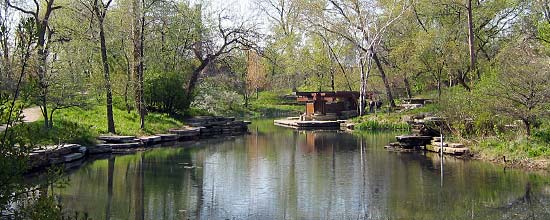

Guidelines for Preserving Cultural Landscapes
Water Features

Identify, Retain, and Preserve Historic Features and Materials
![]()
Identifying, retaining and preserving existing water features and water sources such as retention ponds, pools, and fountains. Documenting shape, edge and bottom condition/material; water level, movement, sound and reflective qualities; and associated plants and animal life and water quality prior to work.
Evaluating the condition and, where applicable the evolution of water features over time. For example, assessing water quality and/or utilizing archeological techniques to determine the changing path of a watercourse.
![]()
Undertaking project work that impacts water features or hydrology, without undertaking an “existing conditions” survey. For example, filling in a pool that provides habitat for rare or endangered wildlife.
Executing project work without understanding its impact on water features. For example, placing a section of stream in a culvert or channel.
Stabilize and Protect Deteriorated Historic Features and Materials
as a Preliminary Measure
![]()
Stabilizing water features by consolidating or reinforcing the form, bottom, or edge treatments. For example, bracing a slipped spill rock in a cascade.
Protecting water features by controlling inappropriate volunteer plant materials. For example, cleaning a pond by removing invasive plant materials.
Protecting water features from hazardous or toxic materials. For example, limiting agricultural fertilizers to minimize their impact on associated streams.
![]()
Failing to stabilize threatened water features. For example, permitting pedestrian access to further degrade threatened embankments.
Allowing invasive vegetation to thrive, leading to radical changes in water quality.
Failing to protect water features from point source, or runoff pollutants, toxins or wastes.
Maintain Historic Features and Materials
![]()
Maintaining water features by use of non-destructive methods and daily, seasonal, and cyclical tasks. For example, cleaning leaf litter or mineral deposits from drainage inlets or outlets.
Maintaining a water feature’s mechanical, plumbing and electrical systems to insure appropriate depth of water or direction of flow. For example, routinely greasing and lubricating gate mechanisms in a canal lock.
![]()
Failing to undertake preventive maintenance to water features.
Utilizing maintenance methods which destroy or degrade water features, such as heavily weighted equipment in the base of a pond, thus destroying its fragile lining.
Allowing mechanical systems to fall into a state of disrepair, resulting in changes to the water feature. For example, failing to maintain a fountain’s plumbing, thus altering its spray.
Repair Historic Materials and Features
![]()
Repairing water features by reinforcing materials or augmenting mechanical systems. For example, patching a crack in an irrigation ditch or repairing a failed pump mechanism.
![]()
Replacing or removing features or systems when repair is possible. For example, abandoning an irrigation system that could be repaired.
Limited Replacement In Kind
of Extensively Deteriorated Portions
of Historic Features
![]()
Replacing in kind a portion of a water feature when it is too deteriorated or damaged to be repaired. For example, installing coping stones in limited areas that match the old in composition, design, color and texture.
![]()
Replacing portions of water features using a new material when the historic material is available.
The managament efforts at the Lily Pool NHL in Lincoln Park in Chicago, Illiinois, includes the preservation and protection of the water's edge by controlling innapropriate volunteer plant material. (NPS, 2004)

The integrity of this historic irrigation system in San Antonio, Texas
has been preserved by keeping it clean of leaf litter and mineral deposits. (NPS, 1992)